Regent College HND Business Environment Report: Sainsbury's Analysis
VerifiedAdded on 2020/06/06
|14
|3937
|40
Report
AI Summary
This report provides a comprehensive analysis of Sainsbury's business environment. It begins with an introduction to the business environment, highlighting the internal and external factors influencing organizational success. The report then delves into the relationship between different organizational functions and their link to organizational objectives and structure, examining the hierarchical levels within Sainsbury's and how they contribute to achieving its goals. A key component of the report involves identifying the positive and negative impacts of the macro environment on Sainsbury's operations, using PESTLE analysis to assess political, economic, social, technological, environmental, and legislative factors. Furthermore, the report conducts both internal and external analyses of Sainsbury's, employing SWOT analysis to identify the company's strengths, weaknesses, opportunities, and threats. Finally, the report explains how these strengths and weaknesses interact with external macro factors, providing a holistic view of Sainsbury's strategic position. The report concludes with a summary of the findings and a list of references.
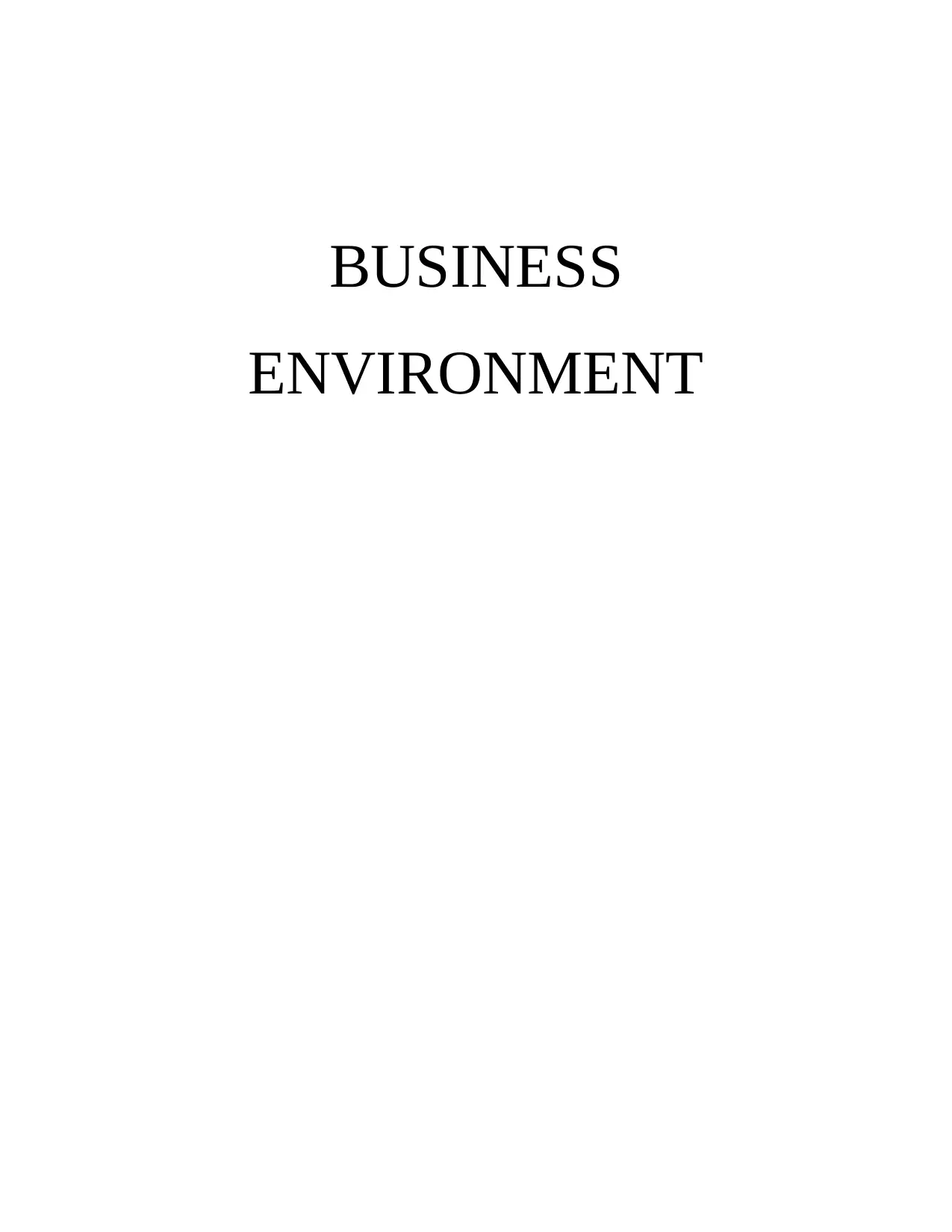
BUSINESS
ENVIRONMENT
ENVIRONMENT
Paraphrase This Document
Need a fresh take? Get an instant paraphrase of this document with our AI Paraphraser
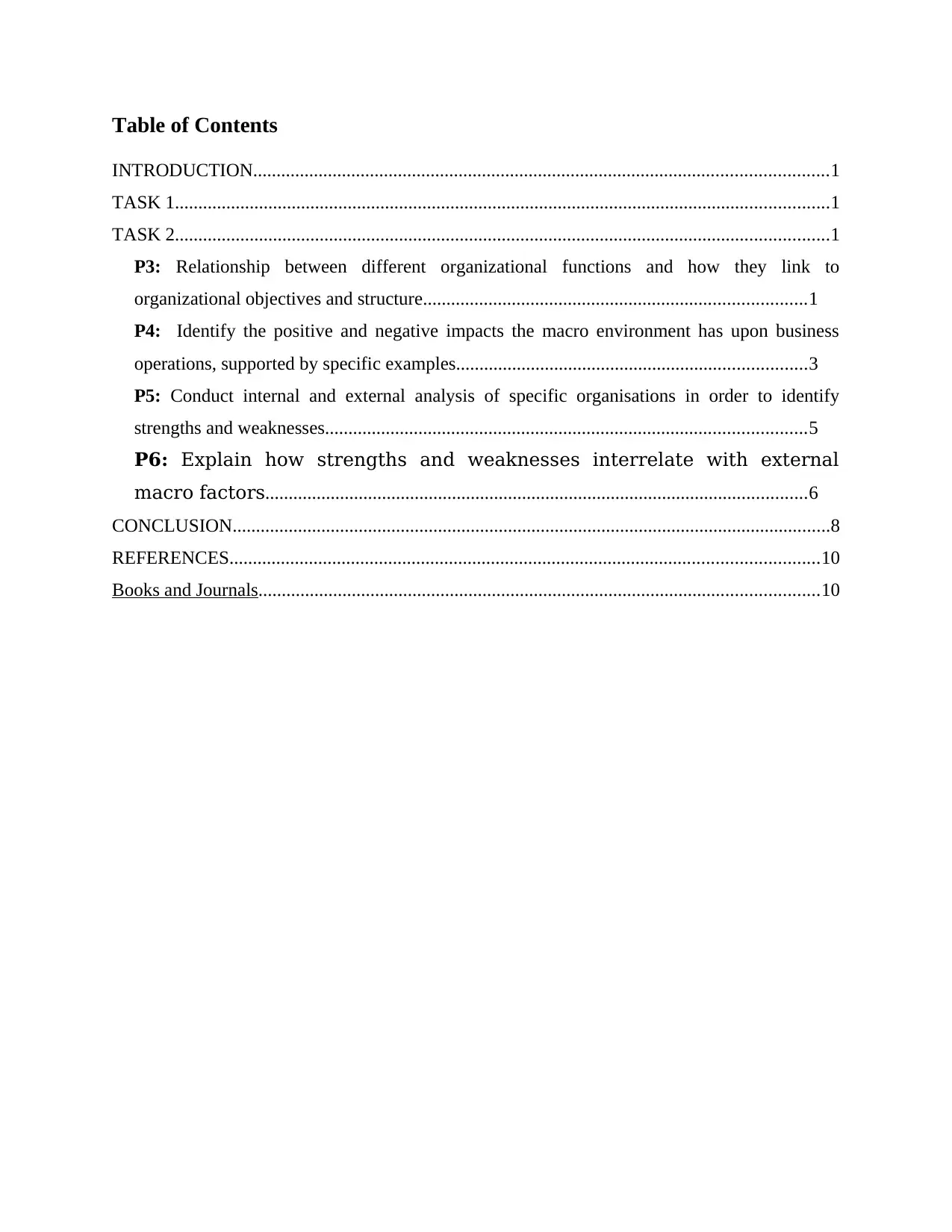
Table of Contents
INTRODUCTION...........................................................................................................................1
TASK 1............................................................................................................................................1
TASK 2............................................................................................................................................1
P3: Relationship between different organizational functions and how they link to
organizational objectives and structure..................................................................................1
P4: Identify the positive and negative impacts the macro environment has upon business
operations, supported by specific examples...........................................................................3
P5: Conduct internal and external analysis of specific organisations in order to identify
strengths and weaknesses.......................................................................................................5
P6: Explain how strengths and weaknesses interrelate with external
macro factors....................................................................................................................6
CONCLUSION................................................................................................................................8
REFERENCES..............................................................................................................................10
Books and Journals........................................................................................................................10
INTRODUCTION...........................................................................................................................1
TASK 1............................................................................................................................................1
TASK 2............................................................................................................................................1
P3: Relationship between different organizational functions and how they link to
organizational objectives and structure..................................................................................1
P4: Identify the positive and negative impacts the macro environment has upon business
operations, supported by specific examples...........................................................................3
P5: Conduct internal and external analysis of specific organisations in order to identify
strengths and weaknesses.......................................................................................................5
P6: Explain how strengths and weaknesses interrelate with external
macro factors....................................................................................................................6
CONCLUSION................................................................................................................................8
REFERENCES..............................................................................................................................10
Books and Journals........................................................................................................................10
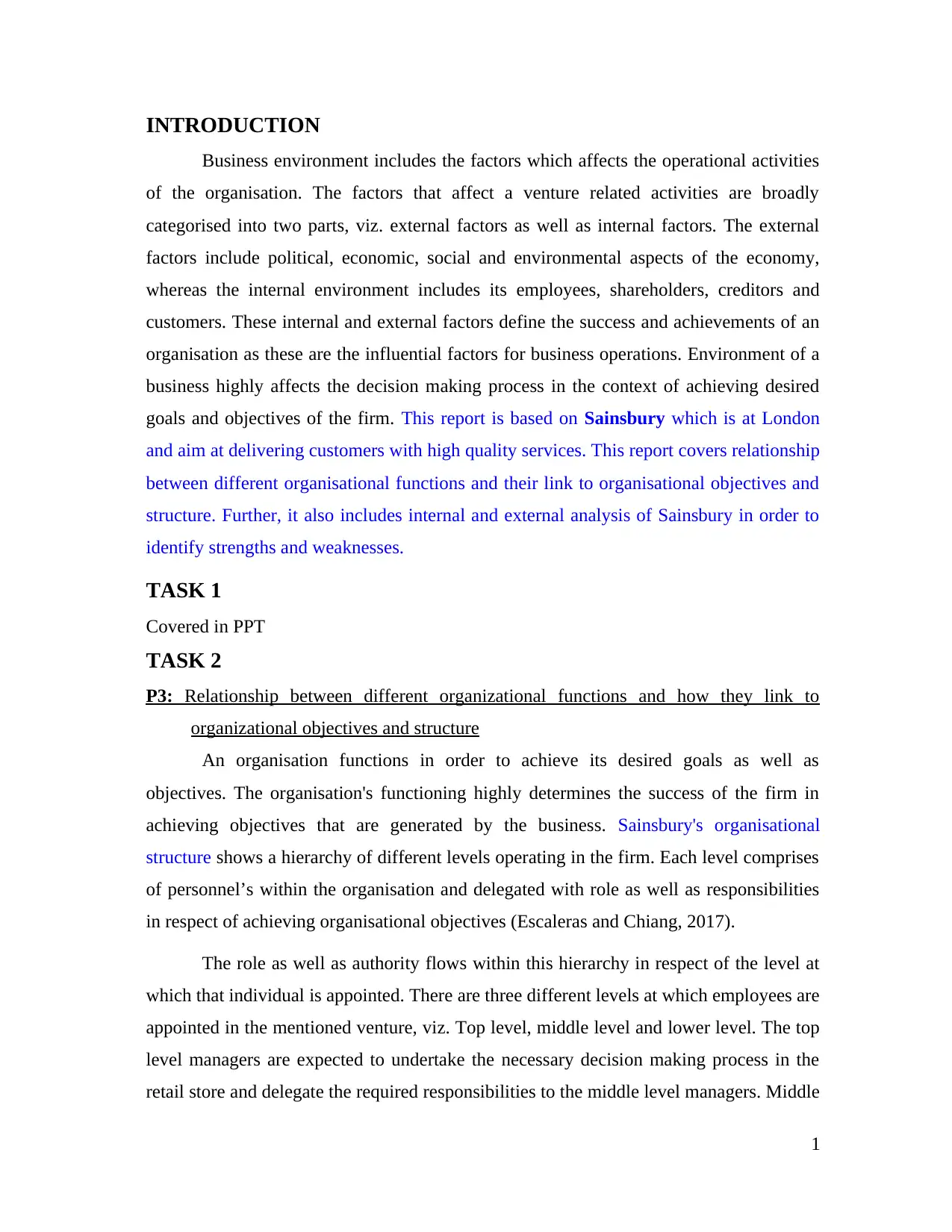
INTRODUCTION
Business environment includes the factors which affects the operational activities
of the organisation. The factors that affect a venture related activities are broadly
categorised into two parts, viz. external factors as well as internal factors. The external
factors include political, economic, social and environmental aspects of the economy,
whereas the internal environment includes its employees, shareholders, creditors and
customers. These internal and external factors define the success and achievements of an
organisation as these are the influential factors for business operations. Environment of a
business highly affects the decision making process in the context of achieving desired
goals and objectives of the firm. This report is based on Sainsbury which is at London
and aim at delivering customers with high quality services. This report covers relationship
between different organisational functions and their link to organisational objectives and
structure. Further, it also includes internal and external analysis of Sainsbury in order to
identify strengths and weaknesses.
TASK 1
Covered in PPT
TASK 2
P3: Relationship between different organizational functions and how they link to
organizational objectives and structure
An organisation functions in order to achieve its desired goals as well as
objectives. The organisation's functioning highly determines the success of the firm in
achieving objectives that are generated by the business. Sainsbury's organisational
structure shows a hierarchy of different levels operating in the firm. Each level comprises
of personnel’s within the organisation and delegated with role as well as responsibilities
in respect of achieving organisational objectives (Escaleras and Chiang, 2017).
The role as well as authority flows within this hierarchy in respect of the level at
which that individual is appointed. There are three different levels at which employees are
appointed in the mentioned venture, viz. Top level, middle level and lower level. The top
level managers are expected to undertake the necessary decision making process in the
retail store and delegate the required responsibilities to the middle level managers. Middle
1
Business environment includes the factors which affects the operational activities
of the organisation. The factors that affect a venture related activities are broadly
categorised into two parts, viz. external factors as well as internal factors. The external
factors include political, economic, social and environmental aspects of the economy,
whereas the internal environment includes its employees, shareholders, creditors and
customers. These internal and external factors define the success and achievements of an
organisation as these are the influential factors for business operations. Environment of a
business highly affects the decision making process in the context of achieving desired
goals and objectives of the firm. This report is based on Sainsbury which is at London
and aim at delivering customers with high quality services. This report covers relationship
between different organisational functions and their link to organisational objectives and
structure. Further, it also includes internal and external analysis of Sainsbury in order to
identify strengths and weaknesses.
TASK 1
Covered in PPT
TASK 2
P3: Relationship between different organizational functions and how they link to
organizational objectives and structure
An organisation functions in order to achieve its desired goals as well as
objectives. The organisation's functioning highly determines the success of the firm in
achieving objectives that are generated by the business. Sainsbury's organisational
structure shows a hierarchy of different levels operating in the firm. Each level comprises
of personnel’s within the organisation and delegated with role as well as responsibilities
in respect of achieving organisational objectives (Escaleras and Chiang, 2017).
The role as well as authority flows within this hierarchy in respect of the level at
which that individual is appointed. There are three different levels at which employees are
appointed in the mentioned venture, viz. Top level, middle level and lower level. The top
level managers are expected to undertake the necessary decision making process in the
retail store and delegate the required responsibilities to the middle level managers. Middle
1
⊘ This is a preview!⊘
Do you want full access?
Subscribe today to unlock all pages.

Trusted by 1+ million students worldwide
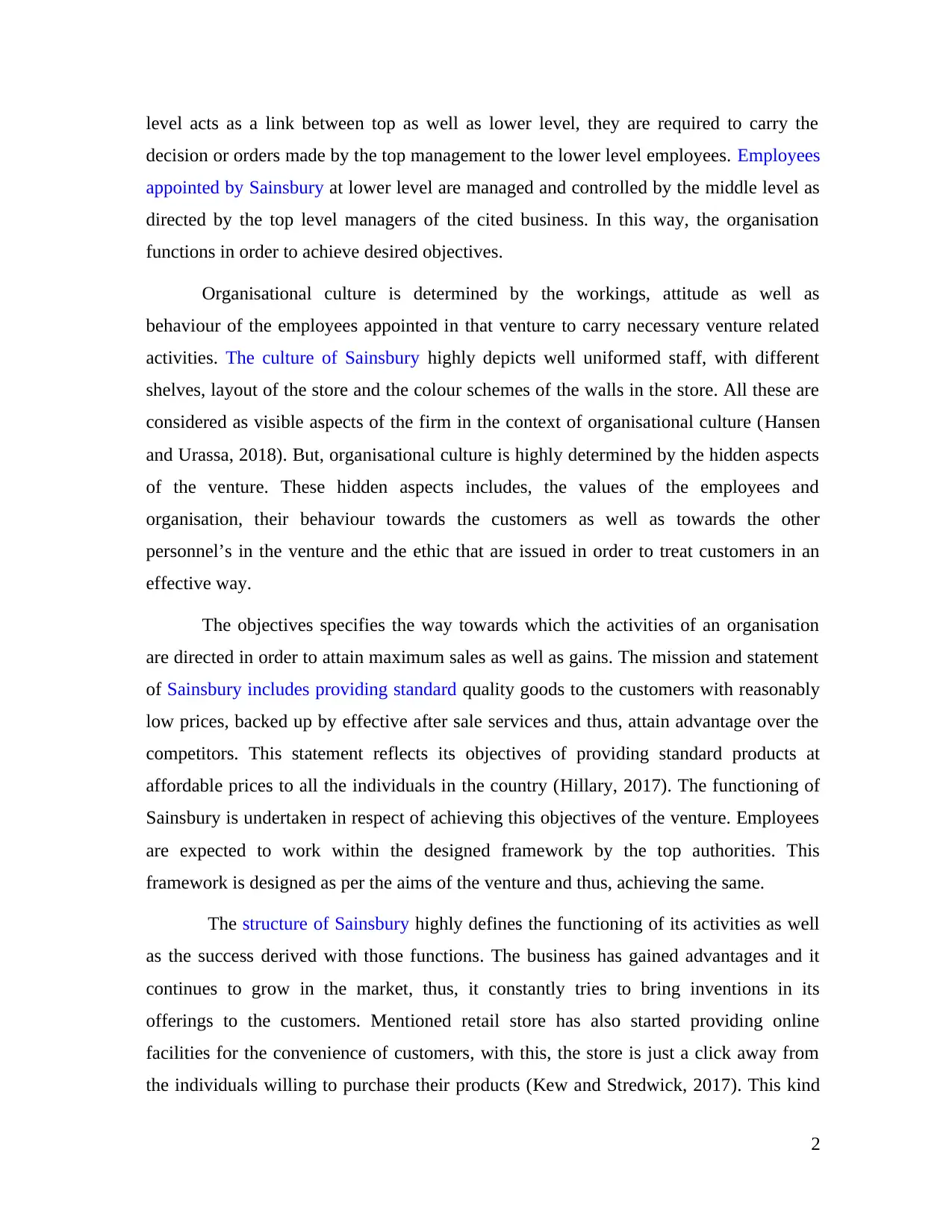
level acts as a link between top as well as lower level, they are required to carry the
decision or orders made by the top management to the lower level employees. Employees
appointed by Sainsbury at lower level are managed and controlled by the middle level as
directed by the top level managers of the cited business. In this way, the organisation
functions in order to achieve desired objectives.
Organisational culture is determined by the workings, attitude as well as
behaviour of the employees appointed in that venture to carry necessary venture related
activities. The culture of Sainsbury highly depicts well uniformed staff, with different
shelves, layout of the store and the colour schemes of the walls in the store. All these are
considered as visible aspects of the firm in the context of organisational culture (Hansen
and Urassa, 2018). But, organisational culture is highly determined by the hidden aspects
of the venture. These hidden aspects includes, the values of the employees and
organisation, their behaviour towards the customers as well as towards the other
personnel’s in the venture and the ethic that are issued in order to treat customers in an
effective way.
The objectives specifies the way towards which the activities of an organisation
are directed in order to attain maximum sales as well as gains. The mission and statement
of Sainsbury includes providing standard quality goods to the customers with reasonably
low prices, backed up by effective after sale services and thus, attain advantage over the
competitors. This statement reflects its objectives of providing standard products at
affordable prices to all the individuals in the country (Hillary, 2017). The functioning of
Sainsbury is undertaken in respect of achieving this objectives of the venture. Employees
are expected to work within the designed framework by the top authorities. This
framework is designed as per the aims of the venture and thus, achieving the same.
The structure of Sainsbury highly defines the functioning of its activities as well
as the success derived with those functions. The business has gained advantages and it
continues to grow in the market, thus, it constantly tries to bring inventions in its
offerings to the customers. Mentioned retail store has also started providing online
facilities for the convenience of customers, with this, the store is just a click away from
the individuals willing to purchase their products (Kew and Stredwick, 2017). This kind
2
decision or orders made by the top management to the lower level employees. Employees
appointed by Sainsbury at lower level are managed and controlled by the middle level as
directed by the top level managers of the cited business. In this way, the organisation
functions in order to achieve desired objectives.
Organisational culture is determined by the workings, attitude as well as
behaviour of the employees appointed in that venture to carry necessary venture related
activities. The culture of Sainsbury highly depicts well uniformed staff, with different
shelves, layout of the store and the colour schemes of the walls in the store. All these are
considered as visible aspects of the firm in the context of organisational culture (Hansen
and Urassa, 2018). But, organisational culture is highly determined by the hidden aspects
of the venture. These hidden aspects includes, the values of the employees and
organisation, their behaviour towards the customers as well as towards the other
personnel’s in the venture and the ethic that are issued in order to treat customers in an
effective way.
The objectives specifies the way towards which the activities of an organisation
are directed in order to attain maximum sales as well as gains. The mission and statement
of Sainsbury includes providing standard quality goods to the customers with reasonably
low prices, backed up by effective after sale services and thus, attain advantage over the
competitors. This statement reflects its objectives of providing standard products at
affordable prices to all the individuals in the country (Hillary, 2017). The functioning of
Sainsbury is undertaken in respect of achieving this objectives of the venture. Employees
are expected to work within the designed framework by the top authorities. This
framework is designed as per the aims of the venture and thus, achieving the same.
The structure of Sainsbury highly defines the functioning of its activities as well
as the success derived with those functions. The business has gained advantages and it
continues to grow in the market, thus, it constantly tries to bring inventions in its
offerings to the customers. Mentioned retail store has also started providing online
facilities for the convenience of customers, with this, the store is just a click away from
the individuals willing to purchase their products (Kew and Stredwick, 2017). This kind
2
Paraphrase This Document
Need a fresh take? Get an instant paraphrase of this document with our AI Paraphraser
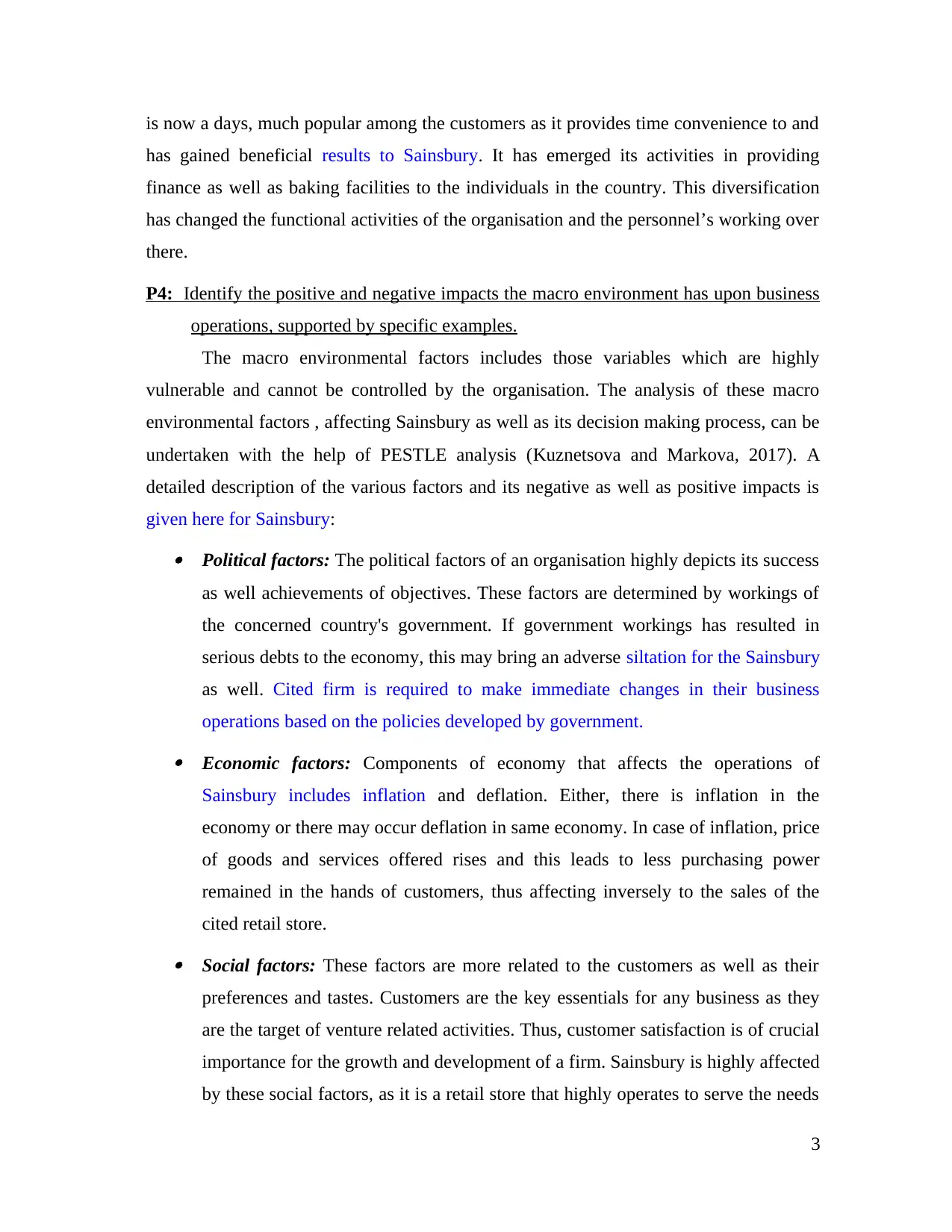
is now a days, much popular among the customers as it provides time convenience to and
has gained beneficial results to Sainsbury. It has emerged its activities in providing
finance as well as baking facilities to the individuals in the country. This diversification
has changed the functional activities of the organisation and the personnel’s working over
there.
P4: Identify the positive and negative impacts the macro environment has upon business
operations, supported by specific examples.
The macro environmental factors includes those variables which are highly
vulnerable and cannot be controlled by the organisation. The analysis of these macro
environmental factors , affecting Sainsbury as well as its decision making process, can be
undertaken with the help of PESTLE analysis (Kuznetsova and Markova, 2017). A
detailed description of the various factors and its negative as well as positive impacts is
given here for Sainsbury: Political factors: The political factors of an organisation highly depicts its success
as well achievements of objectives. These factors are determined by workings of
the concerned country's government. If government workings has resulted in
serious debts to the economy, this may bring an adverse siltation for the Sainsbury
as well. Cited firm is required to make immediate changes in their business
operations based on the policies developed by government. Economic factors: Components of economy that affects the operations of
Sainsbury includes inflation and deflation. Either, there is inflation in the
economy or there may occur deflation in same economy. In case of inflation, price
of goods and services offered rises and this leads to less purchasing power
remained in the hands of customers, thus affecting inversely to the sales of the
cited retail store. Social factors: These factors are more related to the customers as well as their
preferences and tastes. Customers are the key essentials for any business as they
are the target of venture related activities. Thus, customer satisfaction is of crucial
importance for the growth and development of a firm. Sainsbury is highly affected
by these social factors, as it is a retail store that highly operates to serve the needs
3
has gained beneficial results to Sainsbury. It has emerged its activities in providing
finance as well as baking facilities to the individuals in the country. This diversification
has changed the functional activities of the organisation and the personnel’s working over
there.
P4: Identify the positive and negative impacts the macro environment has upon business
operations, supported by specific examples.
The macro environmental factors includes those variables which are highly
vulnerable and cannot be controlled by the organisation. The analysis of these macro
environmental factors , affecting Sainsbury as well as its decision making process, can be
undertaken with the help of PESTLE analysis (Kuznetsova and Markova, 2017). A
detailed description of the various factors and its negative as well as positive impacts is
given here for Sainsbury: Political factors: The political factors of an organisation highly depicts its success
as well achievements of objectives. These factors are determined by workings of
the concerned country's government. If government workings has resulted in
serious debts to the economy, this may bring an adverse siltation for the Sainsbury
as well. Cited firm is required to make immediate changes in their business
operations based on the policies developed by government. Economic factors: Components of economy that affects the operations of
Sainsbury includes inflation and deflation. Either, there is inflation in the
economy or there may occur deflation in same economy. In case of inflation, price
of goods and services offered rises and this leads to less purchasing power
remained in the hands of customers, thus affecting inversely to the sales of the
cited retail store. Social factors: These factors are more related to the customers as well as their
preferences and tastes. Customers are the key essentials for any business as they
are the target of venture related activities. Thus, customer satisfaction is of crucial
importance for the growth and development of a firm. Sainsbury is highly affected
by these social factors, as it is a retail store that highly operates to serve the needs
3
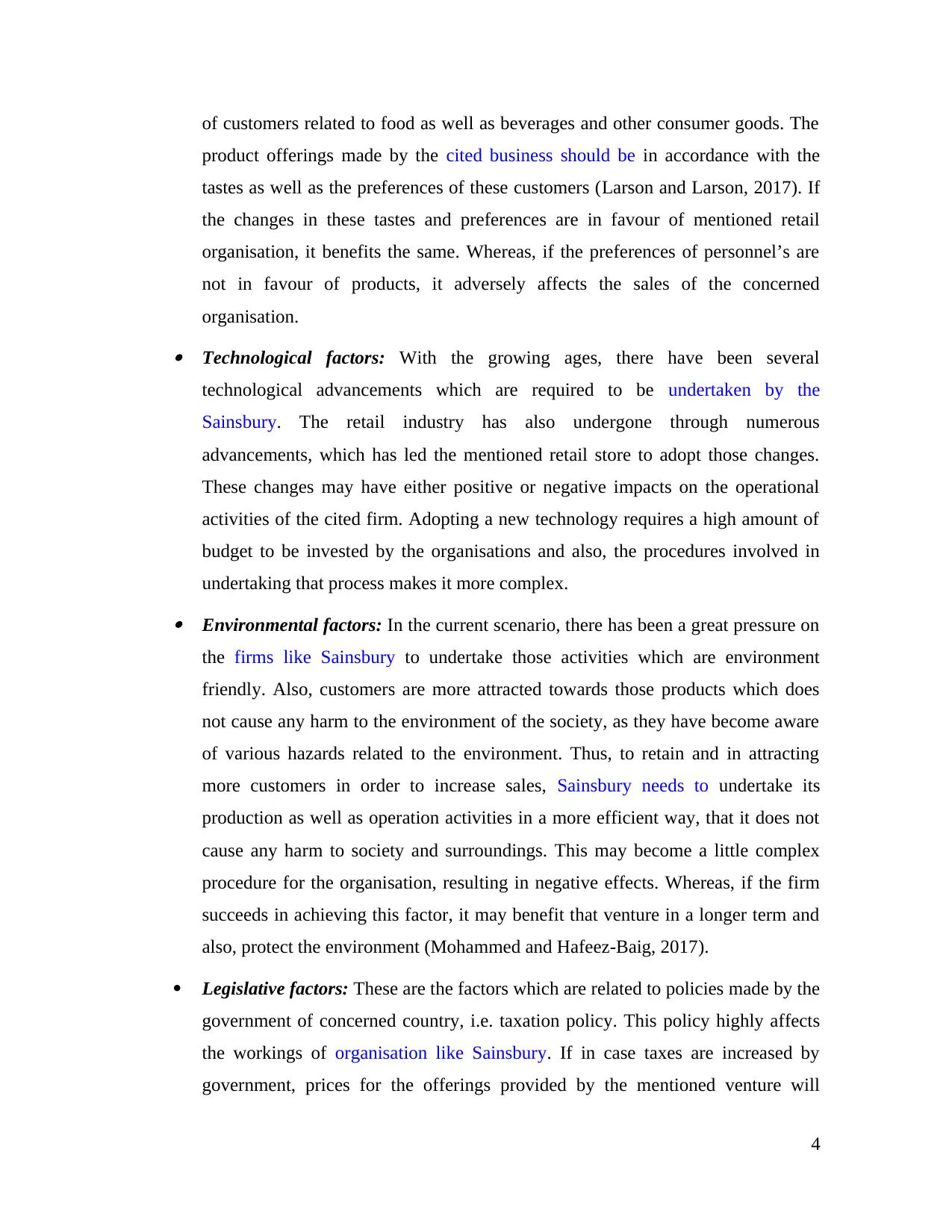
of customers related to food as well as beverages and other consumer goods. The
product offerings made by the cited business should be in accordance with the
tastes as well as the preferences of these customers (Larson and Larson, 2017). If
the changes in these tastes and preferences are in favour of mentioned retail
organisation, it benefits the same. Whereas, if the preferences of personnel’s are
not in favour of products, it adversely affects the sales of the concerned
organisation. Technological factors: With the growing ages, there have been several
technological advancements which are required to be undertaken by the
Sainsbury. The retail industry has also undergone through numerous
advancements, which has led the mentioned retail store to adopt those changes.
These changes may have either positive or negative impacts on the operational
activities of the cited firm. Adopting a new technology requires a high amount of
budget to be invested by the organisations and also, the procedures involved in
undertaking that process makes it more complex. Environmental factors: In the current scenario, there has been a great pressure on
the firms like Sainsbury to undertake those activities which are environment
friendly. Also, customers are more attracted towards those products which does
not cause any harm to the environment of the society, as they have become aware
of various hazards related to the environment. Thus, to retain and in attracting
more customers in order to increase sales, Sainsbury needs to undertake its
production as well as operation activities in a more efficient way, that it does not
cause any harm to society and surroundings. This may become a little complex
procedure for the organisation, resulting in negative effects. Whereas, if the firm
succeeds in achieving this factor, it may benefit that venture in a longer term and
also, protect the environment (Mohammed and Hafeez-Baig, 2017).
Legislative factors: These are the factors which are related to policies made by the
government of concerned country, i.e. taxation policy. This policy highly affects
the workings of organisation like Sainsbury. If in case taxes are increased by
government, prices for the offerings provided by the mentioned venture will
4
product offerings made by the cited business should be in accordance with the
tastes as well as the preferences of these customers (Larson and Larson, 2017). If
the changes in these tastes and preferences are in favour of mentioned retail
organisation, it benefits the same. Whereas, if the preferences of personnel’s are
not in favour of products, it adversely affects the sales of the concerned
organisation. Technological factors: With the growing ages, there have been several
technological advancements which are required to be undertaken by the
Sainsbury. The retail industry has also undergone through numerous
advancements, which has led the mentioned retail store to adopt those changes.
These changes may have either positive or negative impacts on the operational
activities of the cited firm. Adopting a new technology requires a high amount of
budget to be invested by the organisations and also, the procedures involved in
undertaking that process makes it more complex. Environmental factors: In the current scenario, there has been a great pressure on
the firms like Sainsbury to undertake those activities which are environment
friendly. Also, customers are more attracted towards those products which does
not cause any harm to the environment of the society, as they have become aware
of various hazards related to the environment. Thus, to retain and in attracting
more customers in order to increase sales, Sainsbury needs to undertake its
production as well as operation activities in a more efficient way, that it does not
cause any harm to society and surroundings. This may become a little complex
procedure for the organisation, resulting in negative effects. Whereas, if the firm
succeeds in achieving this factor, it may benefit that venture in a longer term and
also, protect the environment (Mohammed and Hafeez-Baig, 2017).
Legislative factors: These are the factors which are related to policies made by the
government of concerned country, i.e. taxation policy. This policy highly affects
the workings of organisation like Sainsbury. If in case taxes are increased by
government, prices for the offerings provided by the mentioned venture will
4
⊘ This is a preview!⊘
Do you want full access?
Subscribe today to unlock all pages.

Trusted by 1+ million students worldwide
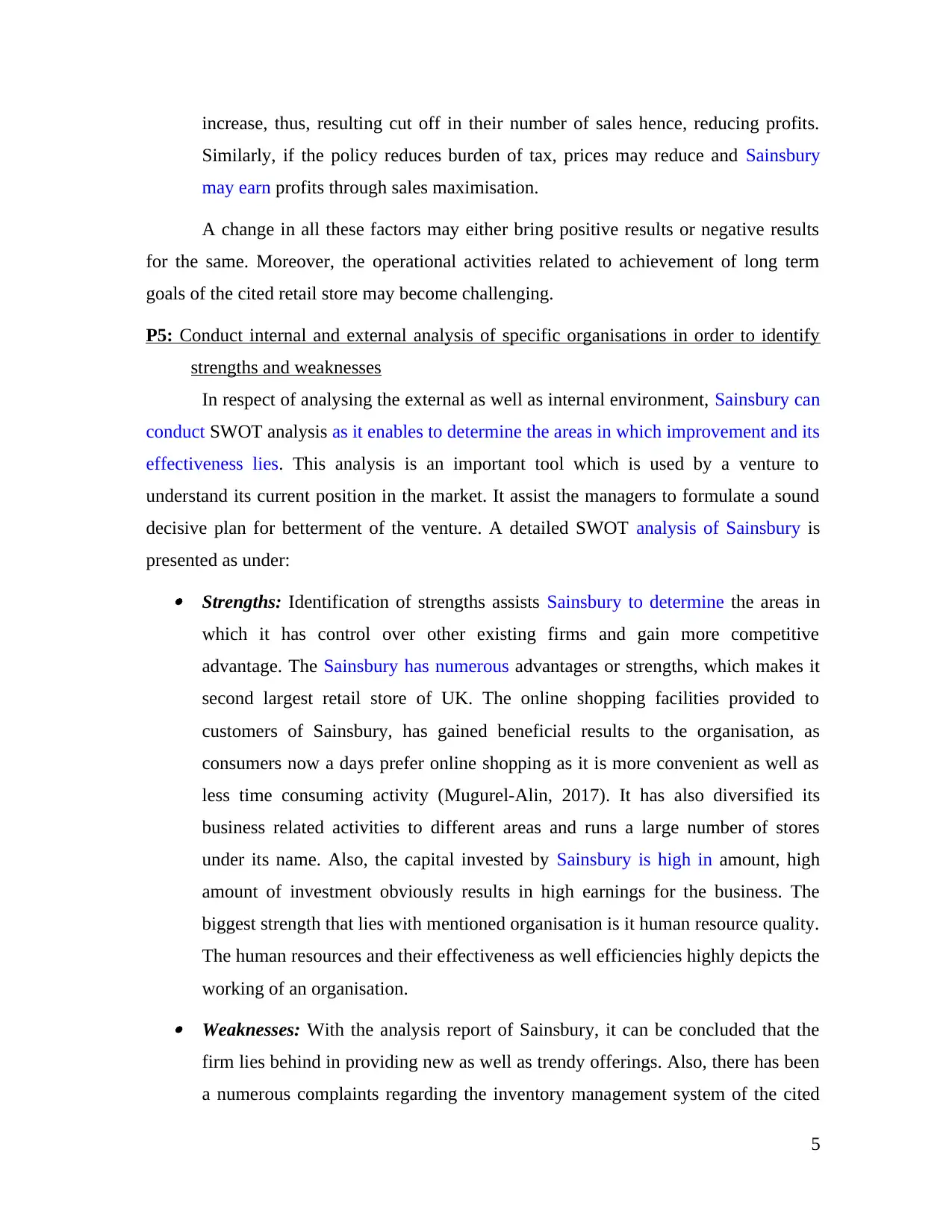
increase, thus, resulting cut off in their number of sales hence, reducing profits.
Similarly, if the policy reduces burden of tax, prices may reduce and Sainsbury
may earn profits through sales maximisation.
A change in all these factors may either bring positive results or negative results
for the same. Moreover, the operational activities related to achievement of long term
goals of the cited retail store may become challenging.
P5: Conduct internal and external analysis of specific organisations in order to identify
strengths and weaknesses
In respect of analysing the external as well as internal environment, Sainsbury can
conduct SWOT analysis as it enables to determine the areas in which improvement and its
effectiveness lies. This analysis is an important tool which is used by a venture to
understand its current position in the market. It assist the managers to formulate a sound
decisive plan for betterment of the venture. A detailed SWOT analysis of Sainsbury is
presented as under: Strengths: Identification of strengths assists Sainsbury to determine the areas in
which it has control over other existing firms and gain more competitive
advantage. The Sainsbury has numerous advantages or strengths, which makes it
second largest retail store of UK. The online shopping facilities provided to
customers of Sainsbury, has gained beneficial results to the organisation, as
consumers now a days prefer online shopping as it is more convenient as well as
less time consuming activity (Mugurel-Alin, 2017). It has also diversified its
business related activities to different areas and runs a large number of stores
under its name. Also, the capital invested by Sainsbury is high in amount, high
amount of investment obviously results in high earnings for the business. The
biggest strength that lies with mentioned organisation is it human resource quality.
The human resources and their effectiveness as well efficiencies highly depicts the
working of an organisation. Weaknesses: With the analysis report of Sainsbury, it can be concluded that the
firm lies behind in providing new as well as trendy offerings. Also, there has been
a numerous complaints regarding the inventory management system of the cited
5
Similarly, if the policy reduces burden of tax, prices may reduce and Sainsbury
may earn profits through sales maximisation.
A change in all these factors may either bring positive results or negative results
for the same. Moreover, the operational activities related to achievement of long term
goals of the cited retail store may become challenging.
P5: Conduct internal and external analysis of specific organisations in order to identify
strengths and weaknesses
In respect of analysing the external as well as internal environment, Sainsbury can
conduct SWOT analysis as it enables to determine the areas in which improvement and its
effectiveness lies. This analysis is an important tool which is used by a venture to
understand its current position in the market. It assist the managers to formulate a sound
decisive plan for betterment of the venture. A detailed SWOT analysis of Sainsbury is
presented as under: Strengths: Identification of strengths assists Sainsbury to determine the areas in
which it has control over other existing firms and gain more competitive
advantage. The Sainsbury has numerous advantages or strengths, which makes it
second largest retail store of UK. The online shopping facilities provided to
customers of Sainsbury, has gained beneficial results to the organisation, as
consumers now a days prefer online shopping as it is more convenient as well as
less time consuming activity (Mugurel-Alin, 2017). It has also diversified its
business related activities to different areas and runs a large number of stores
under its name. Also, the capital invested by Sainsbury is high in amount, high
amount of investment obviously results in high earnings for the business. The
biggest strength that lies with mentioned organisation is it human resource quality.
The human resources and their effectiveness as well efficiencies highly depicts the
working of an organisation. Weaknesses: With the analysis report of Sainsbury, it can be concluded that the
firm lies behind in providing new as well as trendy offerings. Also, there has been
a numerous complaints regarding the inventory management system of the cited
5
Paraphrase This Document
Need a fresh take? Get an instant paraphrase of this document with our AI Paraphraser
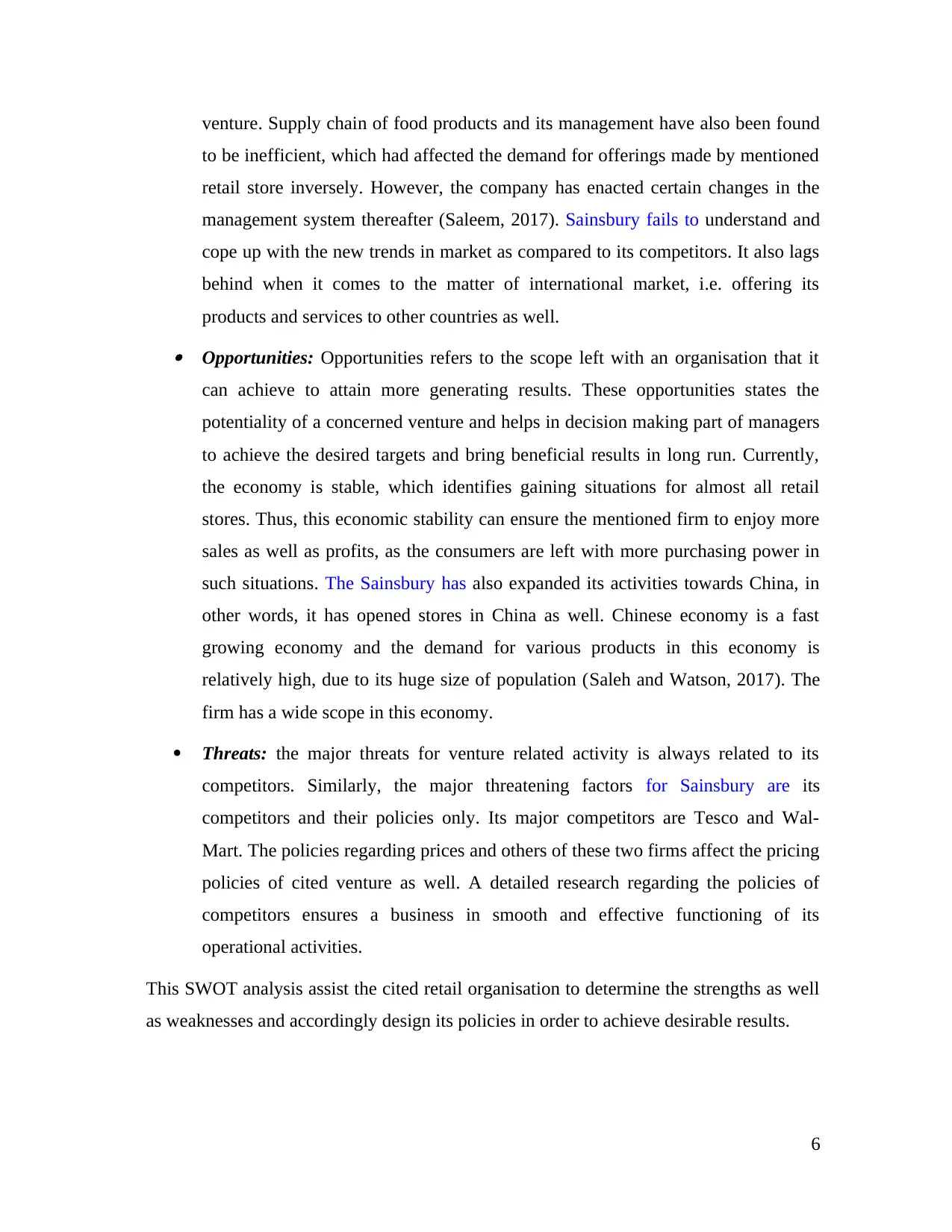
venture. Supply chain of food products and its management have also been found
to be inefficient, which had affected the demand for offerings made by mentioned
retail store inversely. However, the company has enacted certain changes in the
management system thereafter (Saleem, 2017). Sainsbury fails to understand and
cope up with the new trends in market as compared to its competitors. It also lags
behind when it comes to the matter of international market, i.e. offering its
products and services to other countries as well. Opportunities: Opportunities refers to the scope left with an organisation that it
can achieve to attain more generating results. These opportunities states the
potentiality of a concerned venture and helps in decision making part of managers
to achieve the desired targets and bring beneficial results in long run. Currently,
the economy is stable, which identifies gaining situations for almost all retail
stores. Thus, this economic stability can ensure the mentioned firm to enjoy more
sales as well as profits, as the consumers are left with more purchasing power in
such situations. The Sainsbury has also expanded its activities towards China, in
other words, it has opened stores in China as well. Chinese economy is a fast
growing economy and the demand for various products in this economy is
relatively high, due to its huge size of population (Saleh and Watson, 2017). The
firm has a wide scope in this economy.
Threats: the major threats for venture related activity is always related to its
competitors. Similarly, the major threatening factors for Sainsbury are its
competitors and their policies only. Its major competitors are Tesco and Wal-
Mart. The policies regarding prices and others of these two firms affect the pricing
policies of cited venture as well. A detailed research regarding the policies of
competitors ensures a business in smooth and effective functioning of its
operational activities.
This SWOT analysis assist the cited retail organisation to determine the strengths as well
as weaknesses and accordingly design its policies in order to achieve desirable results.
6
to be inefficient, which had affected the demand for offerings made by mentioned
retail store inversely. However, the company has enacted certain changes in the
management system thereafter (Saleem, 2017). Sainsbury fails to understand and
cope up with the new trends in market as compared to its competitors. It also lags
behind when it comes to the matter of international market, i.e. offering its
products and services to other countries as well. Opportunities: Opportunities refers to the scope left with an organisation that it
can achieve to attain more generating results. These opportunities states the
potentiality of a concerned venture and helps in decision making part of managers
to achieve the desired targets and bring beneficial results in long run. Currently,
the economy is stable, which identifies gaining situations for almost all retail
stores. Thus, this economic stability can ensure the mentioned firm to enjoy more
sales as well as profits, as the consumers are left with more purchasing power in
such situations. The Sainsbury has also expanded its activities towards China, in
other words, it has opened stores in China as well. Chinese economy is a fast
growing economy and the demand for various products in this economy is
relatively high, due to its huge size of population (Saleh and Watson, 2017). The
firm has a wide scope in this economy.
Threats: the major threats for venture related activity is always related to its
competitors. Similarly, the major threatening factors for Sainsbury are its
competitors and their policies only. Its major competitors are Tesco and Wal-
Mart. The policies regarding prices and others of these two firms affect the pricing
policies of cited venture as well. A detailed research regarding the policies of
competitors ensures a business in smooth and effective functioning of its
operational activities.
This SWOT analysis assist the cited retail organisation to determine the strengths as well
as weaknesses and accordingly design its policies in order to achieve desirable results.
6
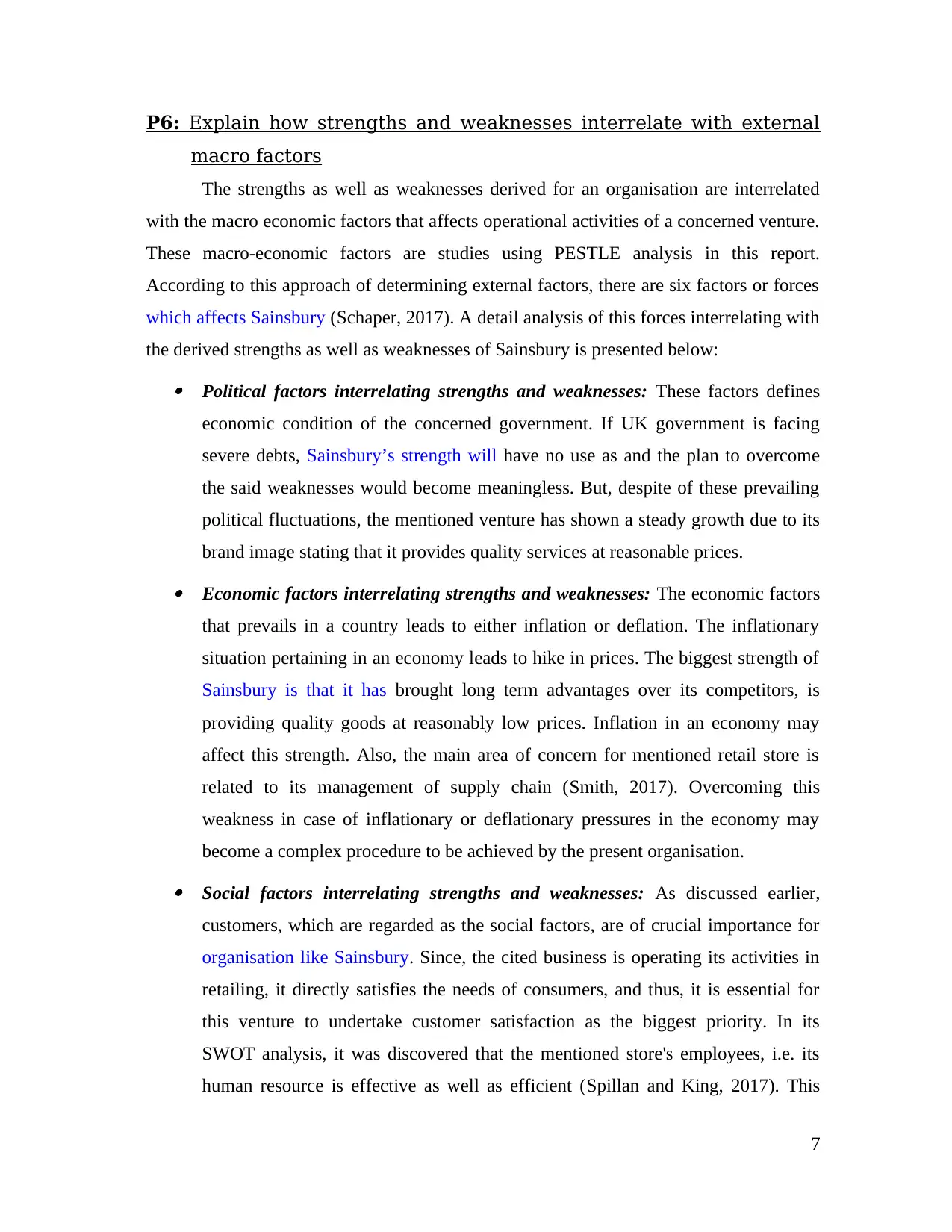
P6: Explain how strengths and weaknesses interrelate with external
macro factors
The strengths as well as weaknesses derived for an organisation are interrelated
with the macro economic factors that affects operational activities of a concerned venture.
These macro-economic factors are studies using PESTLE analysis in this report.
According to this approach of determining external factors, there are six factors or forces
which affects Sainsbury (Schaper, 2017). A detail analysis of this forces interrelating with
the derived strengths as well as weaknesses of Sainsbury is presented below: Political factors interrelating strengths and weaknesses: These factors defines
economic condition of the concerned government. If UK government is facing
severe debts, Sainsbury’s strength will have no use as and the plan to overcome
the said weaknesses would become meaningless. But, despite of these prevailing
political fluctuations, the mentioned venture has shown a steady growth due to its
brand image stating that it provides quality services at reasonable prices. Economic factors interrelating strengths and weaknesses: The economic factors
that prevails in a country leads to either inflation or deflation. The inflationary
situation pertaining in an economy leads to hike in prices. The biggest strength of
Sainsbury is that it has brought long term advantages over its competitors, is
providing quality goods at reasonably low prices. Inflation in an economy may
affect this strength. Also, the main area of concern for mentioned retail store is
related to its management of supply chain (Smith, 2017). Overcoming this
weakness in case of inflationary or deflationary pressures in the economy may
become a complex procedure to be achieved by the present organisation. Social factors interrelating strengths and weaknesses: As discussed earlier,
customers, which are regarded as the social factors, are of crucial importance for
organisation like Sainsbury. Since, the cited business is operating its activities in
retailing, it directly satisfies the needs of consumers, and thus, it is essential for
this venture to undertake customer satisfaction as the biggest priority. In its
SWOT analysis, it was discovered that the mentioned store's employees, i.e. its
human resource is effective as well as efficient (Spillan and King, 2017). This
7
macro factors
The strengths as well as weaknesses derived for an organisation are interrelated
with the macro economic factors that affects operational activities of a concerned venture.
These macro-economic factors are studies using PESTLE analysis in this report.
According to this approach of determining external factors, there are six factors or forces
which affects Sainsbury (Schaper, 2017). A detail analysis of this forces interrelating with
the derived strengths as well as weaknesses of Sainsbury is presented below: Political factors interrelating strengths and weaknesses: These factors defines
economic condition of the concerned government. If UK government is facing
severe debts, Sainsbury’s strength will have no use as and the plan to overcome
the said weaknesses would become meaningless. But, despite of these prevailing
political fluctuations, the mentioned venture has shown a steady growth due to its
brand image stating that it provides quality services at reasonable prices. Economic factors interrelating strengths and weaknesses: The economic factors
that prevails in a country leads to either inflation or deflation. The inflationary
situation pertaining in an economy leads to hike in prices. The biggest strength of
Sainsbury is that it has brought long term advantages over its competitors, is
providing quality goods at reasonably low prices. Inflation in an economy may
affect this strength. Also, the main area of concern for mentioned retail store is
related to its management of supply chain (Smith, 2017). Overcoming this
weakness in case of inflationary or deflationary pressures in the economy may
become a complex procedure to be achieved by the present organisation. Social factors interrelating strengths and weaknesses: As discussed earlier,
customers, which are regarded as the social factors, are of crucial importance for
organisation like Sainsbury. Since, the cited business is operating its activities in
retailing, it directly satisfies the needs of consumers, and thus, it is essential for
this venture to undertake customer satisfaction as the biggest priority. In its
SWOT analysis, it was discovered that the mentioned store's employees, i.e. its
human resource is effective as well as efficient (Spillan and King, 2017). This
7
⊘ This is a preview!⊘
Do you want full access?
Subscribe today to unlock all pages.

Trusted by 1+ million students worldwide
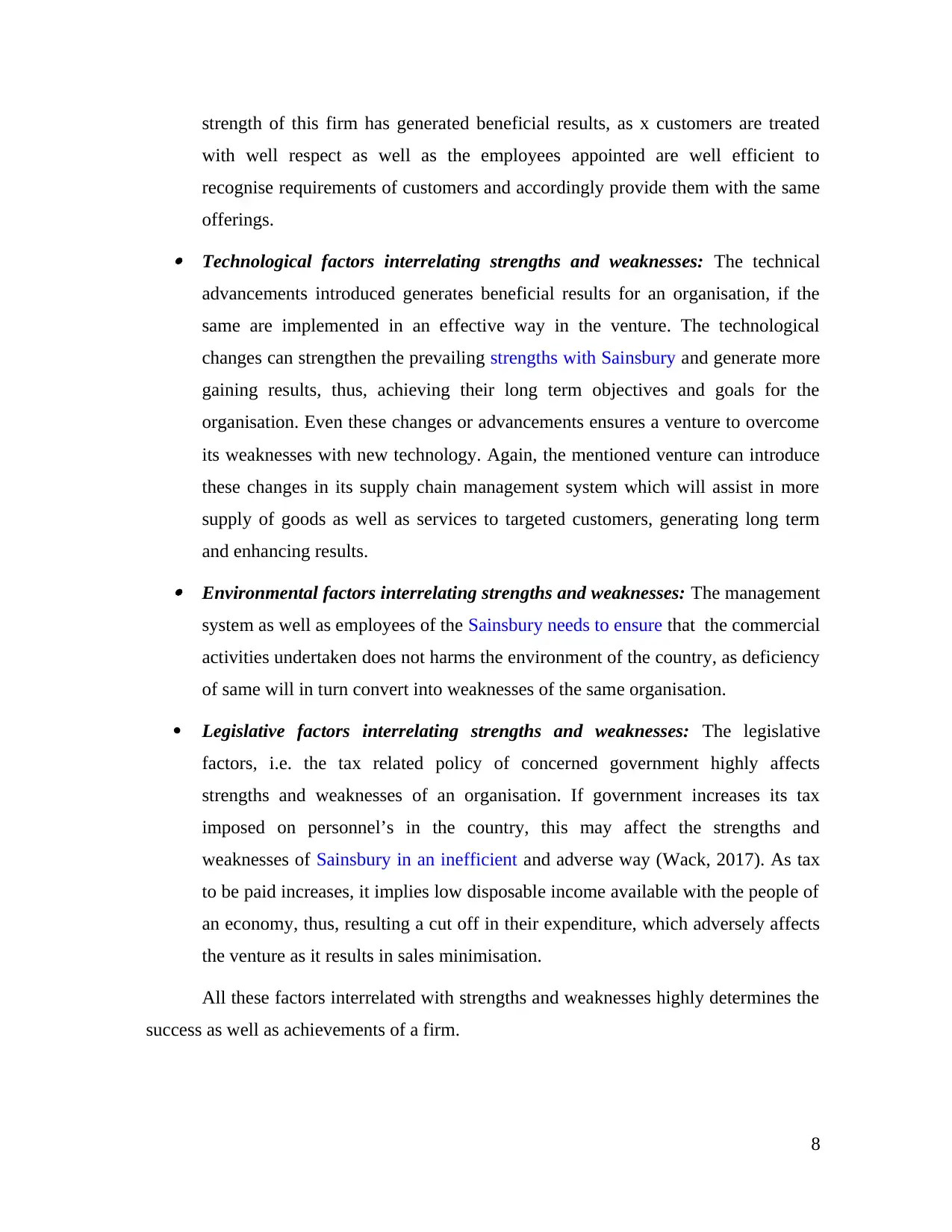
strength of this firm has generated beneficial results, as x customers are treated
with well respect as well as the employees appointed are well efficient to
recognise requirements of customers and accordingly provide them with the same
offerings. Technological factors interrelating strengths and weaknesses: The technical
advancements introduced generates beneficial results for an organisation, if the
same are implemented in an effective way in the venture. The technological
changes can strengthen the prevailing strengths with Sainsbury and generate more
gaining results, thus, achieving their long term objectives and goals for the
organisation. Even these changes or advancements ensures a venture to overcome
its weaknesses with new technology. Again, the mentioned venture can introduce
these changes in its supply chain management system which will assist in more
supply of goods as well as services to targeted customers, generating long term
and enhancing results. Environmental factors interrelating strengths and weaknesses: The management
system as well as employees of the Sainsbury needs to ensure that the commercial
activities undertaken does not harms the environment of the country, as deficiency
of same will in turn convert into weaknesses of the same organisation.
Legislative factors interrelating strengths and weaknesses: The legislative
factors, i.e. the tax related policy of concerned government highly affects
strengths and weaknesses of an organisation. If government increases its tax
imposed on personnel’s in the country, this may affect the strengths and
weaknesses of Sainsbury in an inefficient and adverse way (Wack, 2017). As tax
to be paid increases, it implies low disposable income available with the people of
an economy, thus, resulting a cut off in their expenditure, which adversely affects
the venture as it results in sales minimisation.
All these factors interrelated with strengths and weaknesses highly determines the
success as well as achievements of a firm.
8
with well respect as well as the employees appointed are well efficient to
recognise requirements of customers and accordingly provide them with the same
offerings. Technological factors interrelating strengths and weaknesses: The technical
advancements introduced generates beneficial results for an organisation, if the
same are implemented in an effective way in the venture. The technological
changes can strengthen the prevailing strengths with Sainsbury and generate more
gaining results, thus, achieving their long term objectives and goals for the
organisation. Even these changes or advancements ensures a venture to overcome
its weaknesses with new technology. Again, the mentioned venture can introduce
these changes in its supply chain management system which will assist in more
supply of goods as well as services to targeted customers, generating long term
and enhancing results. Environmental factors interrelating strengths and weaknesses: The management
system as well as employees of the Sainsbury needs to ensure that the commercial
activities undertaken does not harms the environment of the country, as deficiency
of same will in turn convert into weaknesses of the same organisation.
Legislative factors interrelating strengths and weaknesses: The legislative
factors, i.e. the tax related policy of concerned government highly affects
strengths and weaknesses of an organisation. If government increases its tax
imposed on personnel’s in the country, this may affect the strengths and
weaknesses of Sainsbury in an inefficient and adverse way (Wack, 2017). As tax
to be paid increases, it implies low disposable income available with the people of
an economy, thus, resulting a cut off in their expenditure, which adversely affects
the venture as it results in sales minimisation.
All these factors interrelated with strengths and weaknesses highly determines the
success as well as achievements of a firm.
8
Paraphrase This Document
Need a fresh take? Get an instant paraphrase of this document with our AI Paraphraser
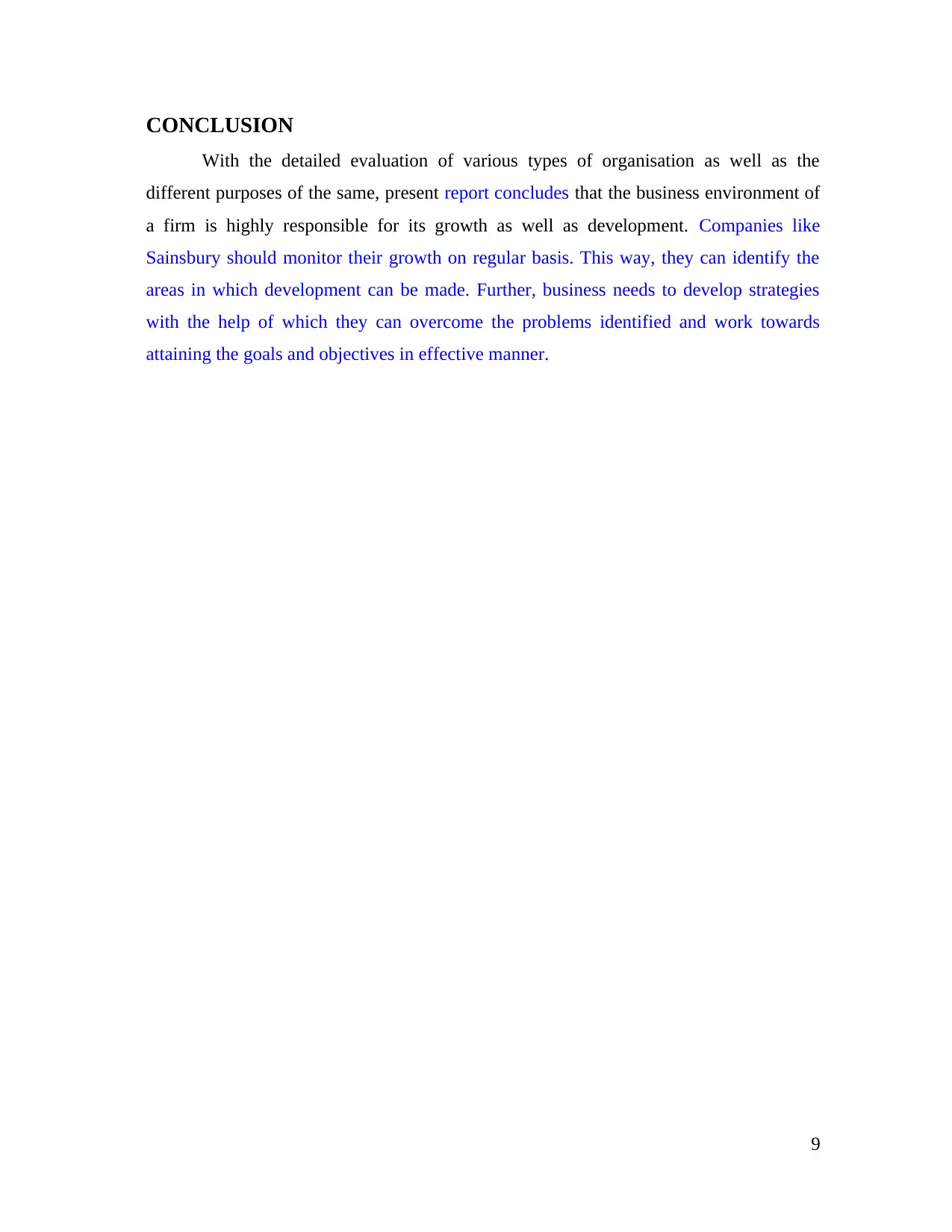
CONCLUSION
With the detailed evaluation of various types of organisation as well as the
different purposes of the same, present report concludes that the business environment of
a firm is highly responsible for its growth as well as development. Companies like
Sainsbury should monitor their growth on regular basis. This way, they can identify the
areas in which development can be made. Further, business needs to develop strategies
with the help of which they can overcome the problems identified and work towards
attaining the goals and objectives in effective manner.
9
With the detailed evaluation of various types of organisation as well as the
different purposes of the same, present report concludes that the business environment of
a firm is highly responsible for its growth as well as development. Companies like
Sainsbury should monitor their growth on regular basis. This way, they can identify the
areas in which development can be made. Further, business needs to develop strategies
with the help of which they can overcome the problems identified and work towards
attaining the goals and objectives in effective manner.
9
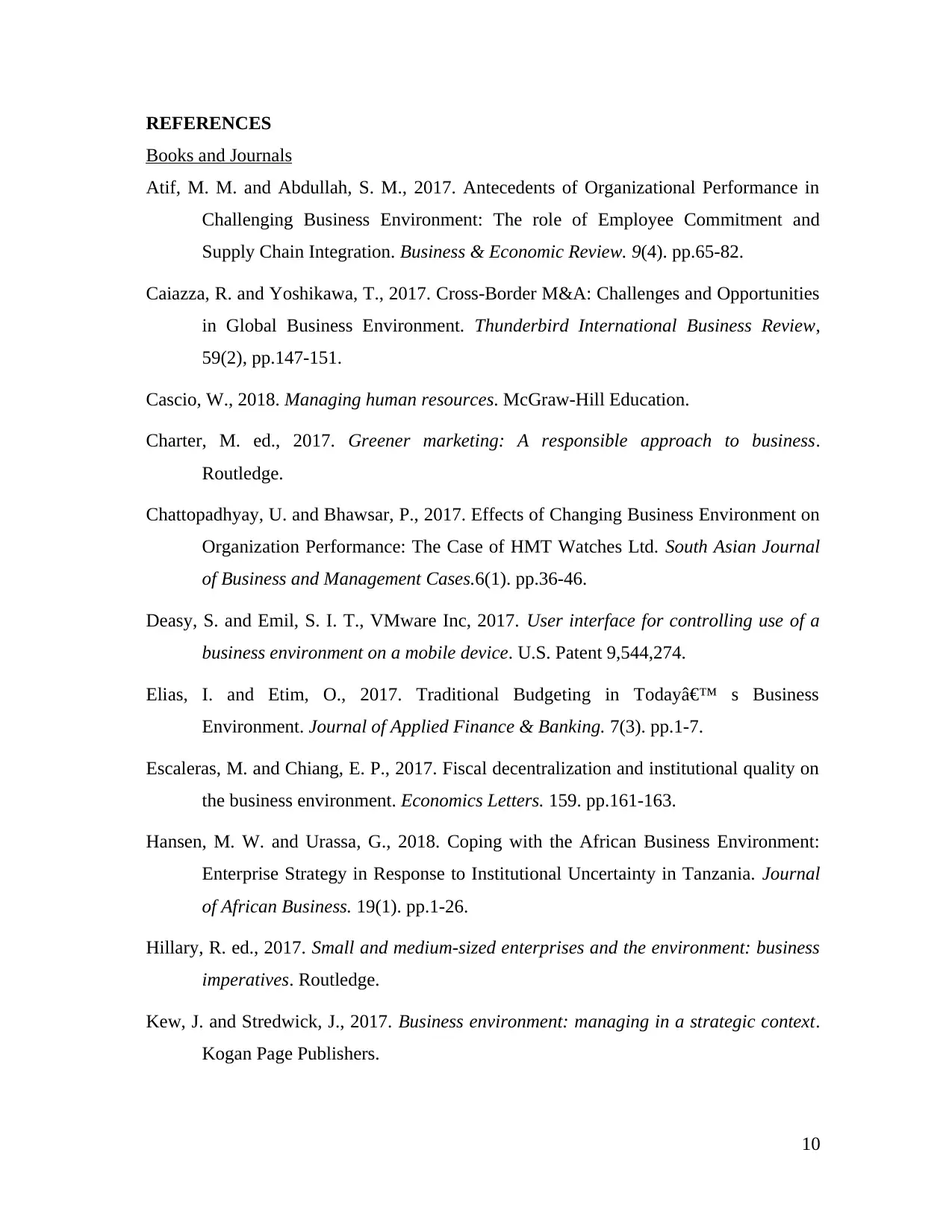
REFERENCES
Books and Journals
Atif, M. M. and Abdullah, S. M., 2017. Antecedents of Organizational Performance in
Challenging Business Environment: The role of Employee Commitment and
Supply Chain Integration. Business & Economic Review. 9(4). pp.65-82.
Caiazza, R. and Yoshikawa, T., 2017. Cross‐Border M&A: Challenges and Opportunities
in Global Business Environment. Thunderbird International Business Review,
59(2), pp.147-151.
Cascio, W., 2018. Managing human resources. McGraw-Hill Education.
Charter, M. ed., 2017. Greener marketing: A responsible approach to business.
Routledge.
Chattopadhyay, U. and Bhawsar, P., 2017. Effects of Changing Business Environment on
Organization Performance: The Case of HMT Watches Ltd. South Asian Journal
of Business and Management Cases.6(1). pp.36-46.
Deasy, S. and Emil, S. I. T., VMware Inc, 2017. User interface for controlling use of a
business environment on a mobile device. U.S. Patent 9,544,274.
Elias, I. and Etim, O., 2017. Traditional Budgeting in Today’ s Business
Environment. Journal of Applied Finance & Banking. 7(3). pp.1-7.
Escaleras, M. and Chiang, E. P., 2017. Fiscal decentralization and institutional quality on
the business environment. Economics Letters. 159. pp.161-163.
Hansen, M. W. and Urassa, G., 2018. Coping with the African Business Environment:
Enterprise Strategy in Response to Institutional Uncertainty in Tanzania. Journal
of African Business. 19(1). pp.1-26.
Hillary, R. ed., 2017. Small and medium-sized enterprises and the environment: business
imperatives. Routledge.
Kew, J. and Stredwick, J., 2017. Business environment: managing in a strategic context.
Kogan Page Publishers.
10
Books and Journals
Atif, M. M. and Abdullah, S. M., 2017. Antecedents of Organizational Performance in
Challenging Business Environment: The role of Employee Commitment and
Supply Chain Integration. Business & Economic Review. 9(4). pp.65-82.
Caiazza, R. and Yoshikawa, T., 2017. Cross‐Border M&A: Challenges and Opportunities
in Global Business Environment. Thunderbird International Business Review,
59(2), pp.147-151.
Cascio, W., 2018. Managing human resources. McGraw-Hill Education.
Charter, M. ed., 2017. Greener marketing: A responsible approach to business.
Routledge.
Chattopadhyay, U. and Bhawsar, P., 2017. Effects of Changing Business Environment on
Organization Performance: The Case of HMT Watches Ltd. South Asian Journal
of Business and Management Cases.6(1). pp.36-46.
Deasy, S. and Emil, S. I. T., VMware Inc, 2017. User interface for controlling use of a
business environment on a mobile device. U.S. Patent 9,544,274.
Elias, I. and Etim, O., 2017. Traditional Budgeting in Today’ s Business
Environment. Journal of Applied Finance & Banking. 7(3). pp.1-7.
Escaleras, M. and Chiang, E. P., 2017. Fiscal decentralization and institutional quality on
the business environment. Economics Letters. 159. pp.161-163.
Hansen, M. W. and Urassa, G., 2018. Coping with the African Business Environment:
Enterprise Strategy in Response to Institutional Uncertainty in Tanzania. Journal
of African Business. 19(1). pp.1-26.
Hillary, R. ed., 2017. Small and medium-sized enterprises and the environment: business
imperatives. Routledge.
Kew, J. and Stredwick, J., 2017. Business environment: managing in a strategic context.
Kogan Page Publishers.
10
⊘ This is a preview!⊘
Do you want full access?
Subscribe today to unlock all pages.

Trusted by 1+ million students worldwide
1 out of 14
Related Documents
Your All-in-One AI-Powered Toolkit for Academic Success.
+13062052269
info@desklib.com
Available 24*7 on WhatsApp / Email
![[object Object]](/_next/static/media/star-bottom.7253800d.svg)
Unlock your academic potential
Copyright © 2020–2025 A2Z Services. All Rights Reserved. Developed and managed by ZUCOL.





